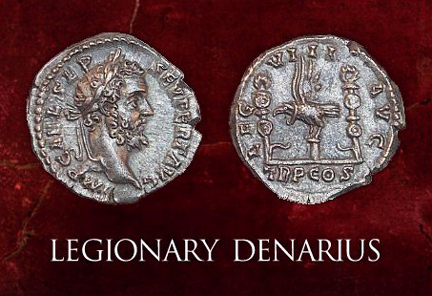

Obv. IMP CAE L SEP SEV PERT AVG. Laureate and bearded head right; Rev. LEG VIII AVG TR P COS. Legionary eagle facing left between two standards. Reference: RIC 11, BMC 14, RSC 267, Sear 1759. The legend on the obverse abbreviates Imperator. Caesar. Lucius. Septimius. Severus. Pertinax. Augustus; in which Severus, styling himself the avenger of the murdered Pertinax, assumed his name. The reverse reads Legio. VIII. Augusta. Tribunicia. Potestas. Consul, which dates the coin to the second half of AD 193, possibly as early as June, when Severus adopted the imperatorial title and tribunician power was conferred by the senate. The consulship already had been held.
This silver denarius is part of the first coinage of Septimius Severus to be issued in Rome after his accession. It both honored and paid the legions which had supported him in his march against the hapless Didius Julianus. Cassius Dio records that the legionaries demanded ten thousand sesterces per man, the equivalent of eight years' pay, claiming that such an amount once had been paid by Octavian (over two centuries before). Severus was able to appease them with a donative of a thousand sesterces (250 denarii) apiece.
This probably was the occasion for the legionary coinage stuck that year, a tradition which had begun with Mark Antony, whose coin type of an aquila between two signa had been introduced to pay for the campaign at Actium in 31 BC (indeed, so numerous was this issue that the coins remained in circulation well after the time of Severus).
Fifteen legions on the Rhine and Danube were recognized by Severus. The first to proclaim him emperor was Legio XIV (Gemina Martia Victrix), which was stationed at Carnuntum (near Vienna), the capital of Upper Pannonia, where Severus resided as governor. It was honored with coinage in bronze, silver, and gold. Gold aurei also were struck in recognition of Legio I (Minerva) and Legio VIII (Augusta) (BMC 13, Kent, 380) and presumably were reserved for senior officers.
The standard numismatic references are Roman Imperial Coinage (RIC), a magisterial review of Roman coinage edited by Harold Mattingly and published in ten volumes; Mattingly's Coins of the Roman Empire in the British Museum (BMC), a six-volume catalog of Roman imperial coins to AD 238, now out of print; and Roman Silver Coins (RSC) by H. A. Seaby, a five-volume set that covers Republican and Imperial silver denominations.
The Millennium Edition of Roman Coins and Their Values by David R. Sear reviews Roman coinage from the Republic through the twelve caesars and revises his earlier, single-volume catalog of Roman coins, which was published in 1988 and now out of print. The two-volume edition of The Coinage and History of the Roman Empire by David L. Vagi also has been recently published. A less expensive introduction is The Handbook of Roman Imperial Coins by David Van Meter, a large format catalog written in 1991 and recently reissued. Ancient Coin Collecting, III: The Roman World—Politics and Propaganda by Wayne G. Sayles and published in 1997 is a popular introductory text.
There also are good books which neither are reference works nor price guides, including Roman Imperial Money (1954) by Michael Grant, Roman History from Coins: Some Uses of the Imperial Coinage to the Historian (1958) by Michael Grant, Historical References on Coins of the Roman Empire (1968) by Edward A. Sydenham, Roman Coins (1978) by J. P. C. Kent and Max and Albert Hirmer, The Monuments of Ancient Rome as Coin Types (1989) by Philip V. Hill, Coinage in the Roman World (1987) by Andrew Burnett; Roman Historical Coins (1990) by Clive Foss; and Monumental Coins: Buildings & Structures on Ancient Coinage (1999) by Marvin Tameanko.